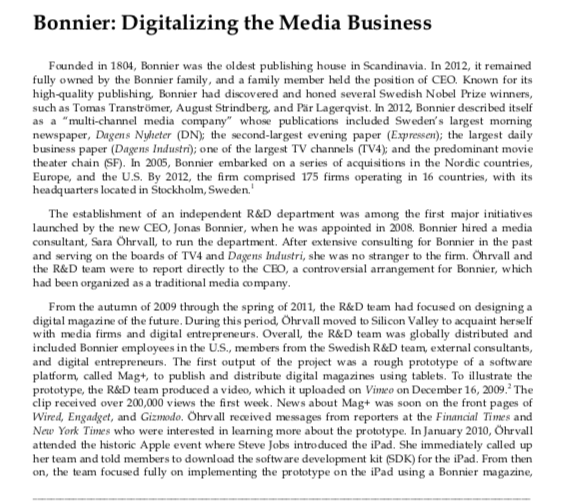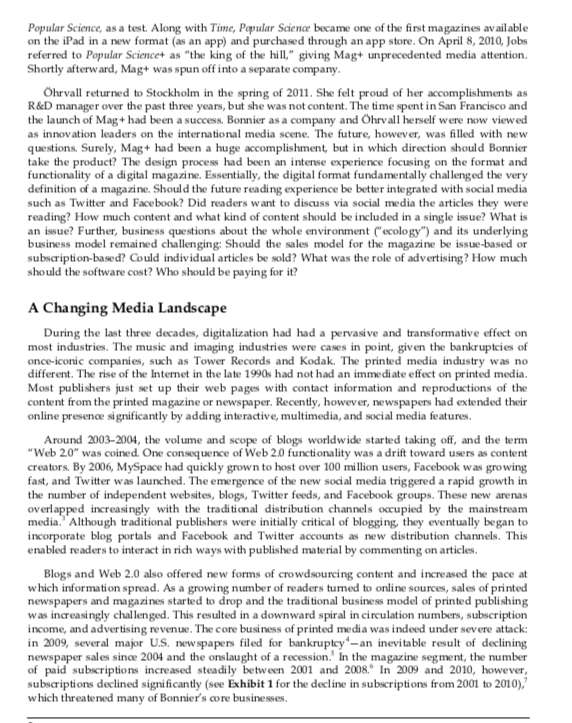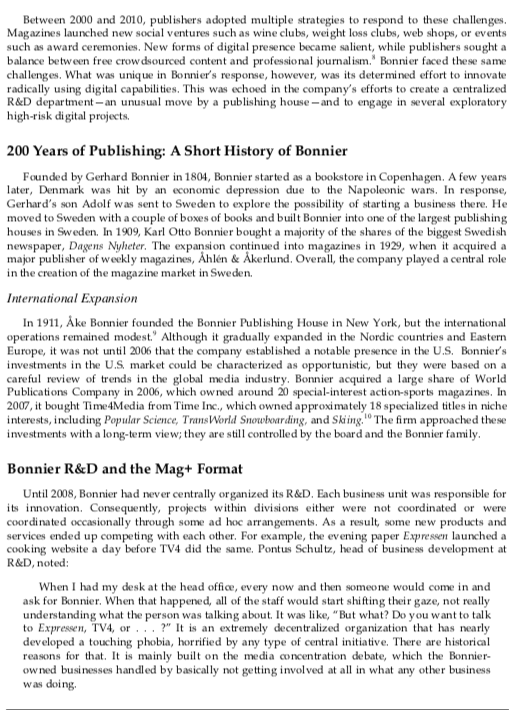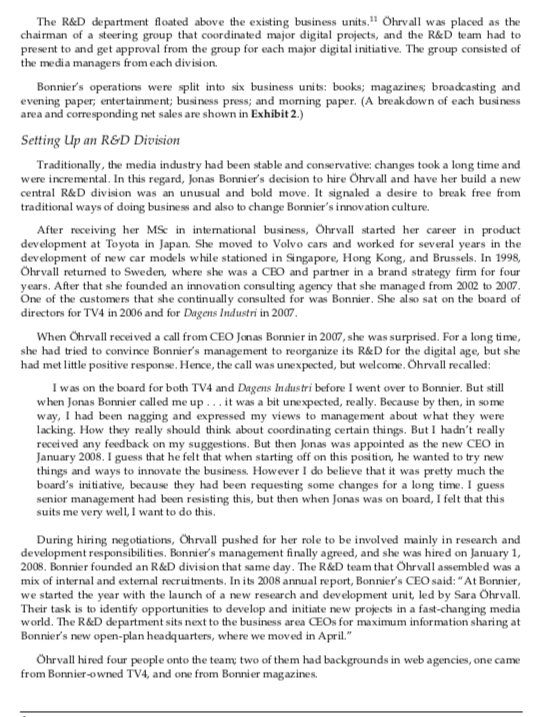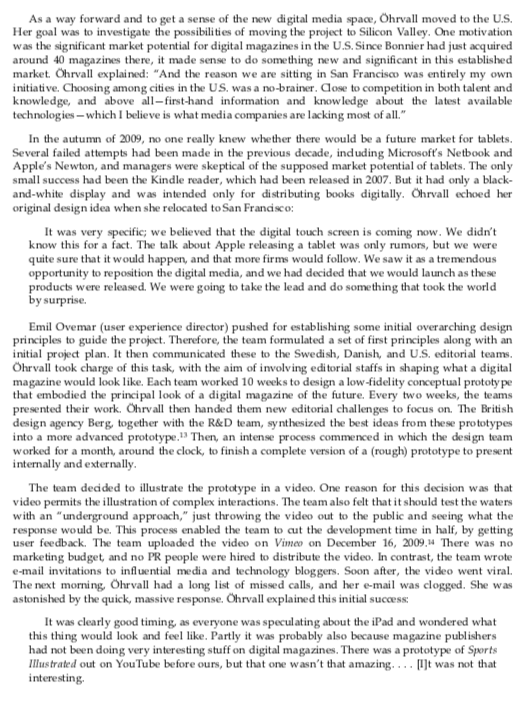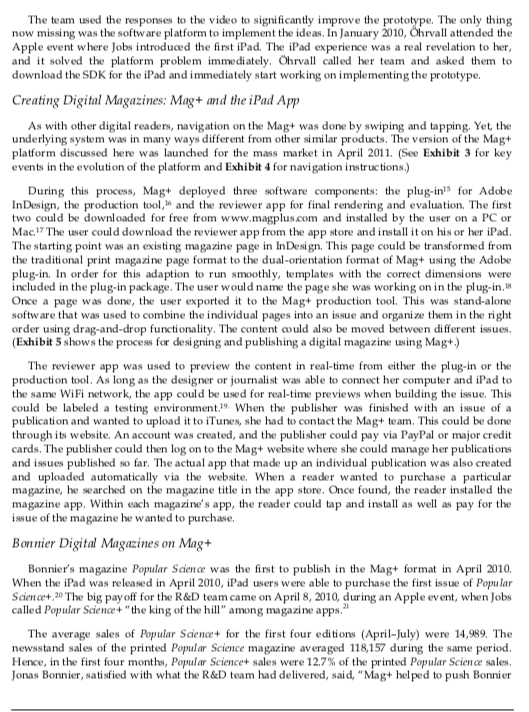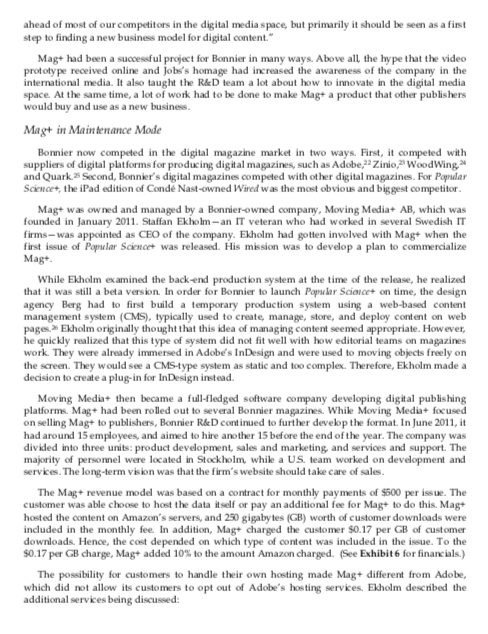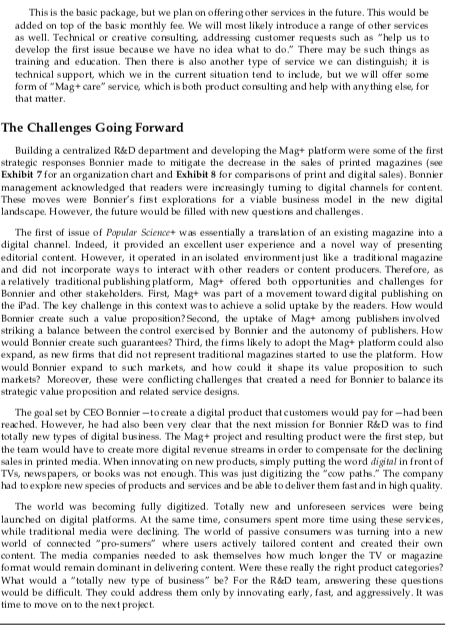In "Bonnier: Digitalizing the Media Business" by Lynda M. Applegate, Daniel Nylen, Jonny Holmstrom, Kalle Lyytinen
Was the approach Bonnier chose to establish acentralized R&D department and to change its innovation practices a soundbusiness decision? What made this decision highly risky?
But then, we should try to incorporate some of the lessons from this week's chapters like:
? what were Bonnier's code competencies?
? how did they chose to leverage them?
? did the way they decided what innovation projects to pursue match the best practices approach outlined in the textbook?
Finally, I would ask you would you have done anything different or approached things in a fundamentally different way?
Bonnier: Digitalizing the Media Business Founded in 1804, Bonnier was the oldest publishing house in Scandinavia. In 2012, it remained fully owned by the Bonnier family, and a family member held the position of CEO, Known for its high-quality publishing, Bonnier had discovered and honed several Swedish Nobel Prize winners, such as Tomas Transtromer, August Strindberg, and Par Lagerqvist. In 2012, Bonnier described itself as a "multi-channel media company" whose publications included Sweden's largest morning newspaper, Dagens Nyheter (DN); the second-largest evening paper (Expressen); the largest daily business paper (Dagens Industri); one of the largest TV channels (TV4); and the predominant movie theater chain (SF). In 2005, Bonnier embarked on a series of acquisitions in the Nordic countries, Europe, and the U.S. By 2012, the firm comprised 175 firms operating in 16 countries, with its headquarters located in Stockholm, Sweden." The establishment of an independent R&D department was among the first major initiatives launched by the new CEO, Jonas Bonnier, when he was appointed in 2008, Bonnier hired a media consultant, Sara Ohrvall, to run the department. After extensive consulting for Bonnier in the past and serving on the boards of TV4 and Dagens Industri, she was no stranger to the firm. Ohrvall and the R&D team were to report directly to the CEO, a controversial arrangement for Bonnier, which had been organized as a traditional media company. From the autumn of 2009 through the spring of 2011, the R&D team had focused on designing a digital magazine of the future. During this period, Ohrvall moved to Silicon Valley to acquaint herself with media firms and digital entrepreneurs. Overall, the R&D team was globally distributed and included Bonnier employees in the U.S., members from the Swedish R&D team, external consultants, and digital entrepreneurs. The first output of the project was a rough prototype of a software platform, called Mag+, to publish and distribute digital magazines using tablets. To illustrate the prototype, the R&D team produced a video, which it uploaded on Vimeo on December 16, 2009.' The clip received over 200,000 views the first week. News about Mag+ was soon on the front pages of Wired, Engadget, and Gizmodo. Ohrvall received messages from reporters at the Financial Times and New York Times who were interested in learning more about the prototype. In January 2010, Ohrvall attended the historic Apple event where Steve Jobs introduced the iPad. She immediately called up her team and told members to download the software development kit (SDK) for the iPad. From then on, the team focused fully on implementing the prototype on the iPad using a Bonnier magazine,Popular Science, as a test. Along with Time, Popular Science became one of the first magazines available on the iPad in a new format (as an app) and purchased through an app store. On April 8, 2010, Jobs referred to Popular Science+ as "the king of the hill," giving Mag+ unprecedented media attention. Shortly afterward, Mag+ was spun off into a separate company. Ohrvall returned to Stockholm in the spring of 2011. She felt proud of her accomplishments as R&D manager over the past three years, but she was not content. The time spent in San Francisco and the launch of Mag + had been a success. Bonnier as a company and Ohrvall herself were now viewed as innovation leaders on the international media scene. The future, however, was filled with new questions. Surely, Mag+ had been a huge accomplishment, but in which direction should Bonnier take the product? The design process had been an intense experience focusing on the format and functionality of a digital magazine. Essentially, the digital format fundamentally challenged the very definition of a magazine. Should the future reading experience be better integrated with social media such as Twitter and Facebook? Did readers want to discuss via social media the articles they were reading? How much content and what kind of content should be included in a single issue? What is an issue? Further, business questions about the whole environment (ecology") and its underlying business model remained challenging: Should the sales model for the magazine be issue-based or subscription-based? Could individual articles be sold? What was the role of advertising? How much should the software cost? Who should be paying for it? A Changing Media Landscape During the last three decades, digitalization had had a pervasive and transformative effect on most industries. The music and imaging industries were cases in point, given the bankruptcies of once-iconic companies, such as Tower Records and Kodak. The printed media industry was no different. The rise of the Internet in the late 1990s had not had an immediate effect on printed media. Most publishers just set up their web pages with contact information and reproductions of the content from the printed magazine or newspaper. Recently, however, newspapers had extended their online presence significantly by adding interactive, multimedia, and social media features. Around 2003-2004, the volume and scope of blogs worldwide started taking off, and the term "Web 20" was coined. One consequence of Web 20 functionality was a drift toward users as content creators. By 2006, MySpace had quickly grown to host over 100 million users, Facebook was growing fast, and Twitter was launched. The emergence of the new social media triggered a rapid growth in the number of independent websites, blogs, Twitter feeds, and Facebook groups. These new arenas overlapped increasingly with the traditional distribution channels occupied by the mainstream media.' Although traditional publishers were initially critical of blogging, they eventually began to incorporate blog portals and Facebook and Twitter accounts as new distribution channels. This enabled readers to interact in rich ways with published material by commenting on articles. Blogs and Web 2.0 also offered new forms of crowdsourcing content and increased the pace at which information spread. As a growing number of readers turned to online sources, sales of printed newspapers and magazines started to drop and the traditional business model of printed publishing was increasingly challenged. This resulted in a downward spiral in circulation numbers, subscription income, and advertising revenue. The core business of printed media was indeed under severe attack: in 2009, several major U.S. newspapers filed for bankruptcy*-an inevitable result of declining newspaper sales since 2004 and the onslaught of a recession.' In the magazine segment, the number of paid subscriptions increased steadily between 2001 and 2008." In 2009 and 2010, however, subscriptions declined significantly (see Exhibit 1 for the decline in subscriptions from 2001 to 2010)," which threatened many of Bonnier's core businesses.Between 2000 and 2010, publishers adopted multiple strategies to respond to these challenges. Magazines launched new social ventures such as wine clubs, weight loss clubs, web shops, or events such as award ceremonies. New forms of digital presence became salient, while publishers sought a balance between free crowdsourced content and professional journalism." Bonnier faced these same challenges. What was unique in Bonnier's response, however, was its determined effort to innovate radically using digital capabilities. This was echoed in the company's efforts to create a centralized R&D department-an unusual move by a publishing house -and to engage in several exploratory high-risk digital projects. 200 Years of Publishing: A Short History of Bonnier Founded by Gerhard Bonnier in 1804, Bonnier started as a bookstore in Copenhagen. A few years later, Denmark was hit by an economic depression due to the Napoleonic wars. In response, Gerhard's son Adolf was sent to Sweden to explore the possibility of starting a business there. He moved to Sweden with a couple of boxes of books and built Bonnier into one of the largest publishing houses in Sweden, In 1909, Karl Otto Bonnier bought a majority of the shares of the biggest Swedish newspaper, Dagens Nyheter. The expansion continued into magazines in 1929, when it acquired a major publisher of weekly magazines, Ahlen & Akerlund. Overall, the company played a central role in the creation of the magazine market in Sweden. International Expansion In 1911, Ake Bonnier founded the Bonnier Publishing House in New York, but the international operations remained modest." Although it gradually expanded in the Nordic countries and Eastern Europe, it was not until 2006 that the company established a notable presence in the U.S. Bonnier's investments in the U.S. market could be characterized as opportunistic, but they were based on a careful review of trends in the global media industry. Bonnier acquired a large share of World Publications Company in 2006, which owned around 20 special-interest action-sports magazines, In 2007, it bought Time4Media from Time Inc., which owned approximately 18 specialized titles in niche interests, including Popular Science, TransWorld Snowboarding, and Skiing. " The firm approached these investments with a long-term view; they are still controlled by the board and the Bonnier family. Bonnier R&D and the Mag+ Format Until 2008, Bonnier had never centrally organized its R&D. Each business unit was responsible for its innovation. Consequently, projects within divisions either were not coordinated or were coordinated occasionally through some ad hoc arrangements. As a result, some new products and services ended up competing with each other. For example, the evening paper Expressen launched a cooking website a day before TV4 did the same. Pontus Schultz, head of business development at R &D, noted: When I had my desk at the head office, every now and then someone would come in and ask for Bonnier. When that happened, all of the staff would start shifting their gaze, not really understanding what the person was talking about. It was like, "But what? Do you want to talk to Expressen, TV4, or . . . ?" It is an extremely decentralized organization that has nearly developed a touching phobia, horrified by any type of central initiative. There are historical reasons for that. It is mainly built on the media concentration debate, which the Bonnier- owned businesses handled by basically not getting involved at all in what any other business was doing.The R&D department floated above the existing business units." Ohrvall was placed as the chairman of a steering group that coordinated major digital projects, and the R&D team had to present to and get approval from the group for each major digital initiative. The group consisted of the media managers from each division. Bonnier's operations were split into six business units: books; magazines; broadcasting and evening paper; entertainment; business press; and morning paper. (A breakdown of each business area and corresponding net sales are shown in Exhibit 2.) Setting Up an R&D Division Traditionally, the media industry had been stable and conservative: changes took a long time and were incremental. In this regard, Jonas Bonnier's decision to hire Ohrvall and have her build a new central R&D division was an unusual and bold move. It signaled a desire to break free from traditional ways of doing business and also to change Bonnier's innovation culture. After receiving her MSc in international business, Ohrvall started her career in product development at Toyota in Japan. She moved to Volvo cars and worked for several years in the development of new car models while stationed in Singapore, Hong Kong, and Brussels. In 1998, Ohrvall returned to Sweden, where she was a CEO and partner in a brand strategy firm for four years. After that she founded an innovation consulting agency that she managed from 2002 to 2007. One of the customers that she continually consulted for was Bonnier. She also sat on the board of directors for TV4 in 2006 and for Dagens Industri in 2007. When Ohrvall received a call from CEO Jonas Bonnier in 2007, she was surprised. For a long time, she had tried to convince Bonnier's management to reorganize its R&D for the digital age, but she had met little positive response. Hence, the call was unexpected, but welcome. Ohrvall recalled: I was on the board for both TV4 and Dagens Industri before I went over to Bonnier. But still when Jonas Bonnier called me up . . . it was a bit unexpected, really. Because by then, in some way, I had been nagging and expressed my views to management about what they were lacking. How they really should think about coordinating certain things. But I hadn't really received any feedback on my suggestions. But then Jonas was appointed as the new CEO in January 2008. I guess that he felt that when starting off on this position, he wanted to try new things and ways to innovate the business. However I do believe that it was pretty much the board's initiative, because they had been requesting some changes for a long time. I guess senior management had been resisting this, but then when Jonas was on board, I felt that this suits me very well, I want to do this. During hiring negotiations, Ohrvall pushed for her role to be involved mainly in research and development responsibilities. Bonnier's management finally agreed, and she was hired on January 1, 2008. Bonnier founded an R&D division that same day. The R&D team that Ohrvall assembled was a mix of internal and external recruitments. In its 2008 annual report, Bonnier's CEO said: " At Bonnier, we started the year with the launch of a new research and development unit, led by Sara Ohrvall. Their task is to identify opportunities to develop and initiate new projects in a fast-changing media world. The R&D department sits next to the business area CEOs for maximum information sharing at Bonnier's new open-plan headquarters, where we moved in April." Ohrvall hired four people onto the team; two of them had backgrounds in web agencies, one came from Bonnier-owned TV4, and one from Bonnier magazines.Projects Early on, the R&D department had to work hard to legitimize itself. The very decision to start a central R&D department was seen as highly controversial. Division managers questioned R&D's role and value. They were worried that the new department would control all their new projects or dictate what they should do. Ohrvall recalled: For a lot of companies, it is very safe to employ someone who only works with business intelligence. It's a very "nice thing to have." The business intelligence guy is a person you can use externally - he can go to lectures, give presentations, and he can be a bit of fun to listen to. He can attend all the annual meetings - he's like a little mascot. But as soon as you're going to work with development, you are dangerous, and you're a worrying person that suggests changes that will hurt a little. Companies are likely to get stuck in a situation where . . . "it's nice to get some good advice," but that's it. Ohrvall wanted the R&D team to be perceived as a unit that questioned ways of doing business and was annoying, yet in a respectful way: "The most important thing for an R&D department is that you have the space to challenge the existing business, As soon as you do not have that space, and you are compromising to the extent that you're getting a bit harmless, then you're not really R&D any longer. Then you are some kind of business development resource for existing businesses. It has to hurt a little to work with an R&D department." The first product the R&D team delivered was a news commentary and debate site, www.newsmill.se, in September 2008. The site was run by a few editors, and the public sent in articles. Hence, the site employed a user-created content model-a form of crowdsourcing. The site was nominated for the Swedish annual award "The Swedish Grand Journalism Prize," in the category "Innovation of the Year," in 2009."- The R&D team also launched an online R&D lab in January 2009. Going to San Francisco During the autumn of 2009, the R&D team started to work on a digital magazine, Based on the general understanding that Bonnier's magazine business was under threat and its digital delivery was not satisfactory, the task was to create a digital publishing product that customers would be willing to pay for. The R&D team initially struggled when it tried to narrow the scope of the project and visualize concrete products. "I remember when we started the project and we sat and felt like, this is the dumbest thing we ever did," recalled Pontus Schultz, He continued: Someone would come up with an idea that seemed great, but then someone else in the team would say, "It's called the Internet and that already exists!" I recall that at some point Jonas [ Bonnier] came in, giving a kind of pep talk, saying "You know what? Imagine this: the best minds in the industry have spent 15 years in addressing this issue, and they haven't come up with anything. You will not know more in February than you know now, so you might as well start doing something." Somehow, it was good, because we just rigged the project anyway. We realized that whatever conclusion we make, it would be wrong. It is quite a pleasant insight in some way, because first of all you can start to get busy working. Second, you realize that you have to rig the project in a way so that you can constantly twist and turn the levers. And that has to be done in some sort of close collaboration with the readers, the advertisers, and the hardware people. I think that was the great insight.As a way forward and to get a sense of the new digital media space, Ohrvall moved to the U.S. Her goal was to investigate the possibilities of moving the project to Silicon Valley. One motivation was the significant market potential for digital magazines in the U.S. Since Bonnier had just acquired around 40 magazines there, it made sense to do something new and significant in this established market. Ohrvall explained: "And the reason we are sitting in San Francisco was entirely my own initiative. Choosing among cities in the US. was a no-brainer. Close to competition in both talent and knowledge, and above all-first-hand information and knowledge about the latest available technologies -which I believe is what media companies are lacking most of all." In the autumn of 2009, no one really knew whether there would be a future market for tablets. Several failed attempts had been made in the previous decade, induding Microsoft's Netbook and Apple's Newton, and managers were skeptical of the supposed market potential of tablets. The only small success had been the Kindle reader, which had been released in 2007. But it had only a black- and-white display and was intended only for distributing books digitally. Ohrvall echoed her original design idea when she relocated to San Frandisco: It was very specific; we believed that the digital touch screen is coming now. We didn't know this for a fact. The talk about Apple releasing a tablet was only rumors, but we were quite sure that it would happen, and that more firms would follow. We saw it as a tremendous opportunity to reposition the digital media, and we had decided that we would launch as these products were released. We were going to take the lead and do something that took the world by surprise. Emil Ovemar (user experience director) pushed for establishing some initial overarching design principles to guide the project. Therefore, the team formulated a set of first principles along with an initial project plan. It then communicated these to the Swedish, Danish, and U.S. editorial teams. Ohrvall took charge of this task, with the aim of involving editorial staffs in shaping what a digital magazine would look like. Each team worked 10 weeks to design a low-fidelity conceptual prototype that embodied the principal look of a digital magazine of the future. Every two weeks, the teams presented their work. Ohrvall then handed them new editorial challenges to focus on. The British design agency Berg, together with the R&D team, synthesized the best ideas from these prototypes into a more advanced prototype." Then, an intense process commenced in which the design team worked for a month, around the clock, to finish a complete version of a (rough) prototype to present internally and externally. The team decided to illustrate the prototype in a video. One reason for this decision was that video permits the illustration of complex interactions. The team also felt that it should test the waters with an "underground approach," just throwing the video out to the public and seeing what the response would be. This process enabled the team to cut the development time in half, by getting user feedback. The team uploaded the video on Vimeo on December 16, 2009." There was no marketing budget, and no PR people were hired to distribute the video. In contrast, the team wrote e-mail invitations to influential media and technology bloggers. Soon after, the video went viral. The next morning, Ohrvall had a long list of missed calls, and her e-mail was clogged. She was astonished by the quick, massive response. Ohrvall explained this initial success; It was clearly good timing, as everyone was speculating about the iPad and wondered what this thing would look and feel like. Partly it was probably also because magazine publishers had not been doing very interesting stuff on digital magazines. There was a prototype of Sports Illustrated out on You Tube before ours, but that one wasn't that amazing. . . . [Ijt was not that interesting.The team used the responses to the video to significantly improve the prototype. The only thing now missing was the software platform to implement the ideas. In January 2010, Ohrvall attended the Apple event where Jobs introduced the first iPad. The iPad experience was a real revelation to her, and it solved the platform problem immediately. Ohrvall called her team and asked them to download the SDK for the iPad and immediately start working on implementing the prototype. Creating Digital Magazines: Mag+ and the iPad App As with other digital readers, navigation on the Mag+ was done by swiping and tapping. Yet, the underlying system was in many ways different from other similar products. The version of the Mag+ platform discussed here was launched for the mass market in April 2011. (See Exhibit 3 for key events in the evolution of the platform and Exhibit 4 for navigation instructions.) During this process, Mag+ deployed three software components: the plug-in for Adobe InDesign, the production tool," and the reviewer app for final rendering and evaluation. The first two could be downloaded for free from www.magplus.com and installed by the user on a PC or Mac17 The user could download the reviewer app from the app store and install it on his or her iPad The starting point was an existing magazine page in InDesign. This page could be transformed from the traditional print magazine page format to the dual-orientation format of Mag+ using the Adobe plug-in. In order for this adaption to run smoothly, templates with the correct dimensions were included in the plug-in package. The user would name the page she was working on in the plug-in." Once a page was done, the user exported it to the Mag+ production tool. This was stand-alone software that was used to combine the individual pages into an issue and organize them in the right order using drag-and-drop functionality. The content could also be moved between different issues. (Exhibit 5 shows the process for designing and publishing a digital magazine using Mag+.) The reviewer app was used to preview the content in real-time from either the plug-in or the production tool. As long as the designer or journalist was able to connect her computer and iPad to the same WiFi network, the app could be used for real-time previews when building the issue. This could be labeled a testing environment."" When the publisher was finished with an issue of a publication and wanted to upload it to iTunes, she had to contact the Mag+ team. This could be done through its website. An account was created, and the publisher could pay via PayPal or major credit cards. The publisher could then log on to the Mag+ website where she could manage her publications and issues published so far. The actual app that made up an individual publication was also created and uploaded automatically via the website. When a reader wanted to purchase a particular magazine, he searched on the magazine title in the app store. Once found, the reader installed the magazine app. Within each magazine's app, the reader could tap and install as well as pay for the issue of the magazine he wanted to purchase. Bonnier Digital Magazines on Mag+ Bonnier's magazine Popular Science was the first to publish in the Mag+ format in April 2010. When the iPad was released in April 2010, iPad users were able to purchase the first issue of Popular Science+." The big payoff for the R&D team came on April 8, 2010, during an Apple event, when Jobs called Popular Science+ "the king of the hill" among magazine apps." The average sales of Popular Science+ for the first four editions (April-July) were 14,989, The newsstand sales of the printed Popular Science magazine averaged 118,157 during the same period. Hence, in the first four months, Popular Science+ sales were 127% of the printed Popular Science sales. Jonas Bonnier, satisfied with what the R&D team had delivered, said, "Mag+ helped to push Bonnierahead of most of our competitors in the digital media space, but primarily it should be seen as a first step to finding a new business model for digital content." Mag+ had been a successful project for Bonnier in many ways. Above all, the hype that the video prototype received online and Jobs's homage had increased the awareness of the company in the international media. It also taught the RAD team a lot about how to innovate in the digital media space At the same time, a lot of work had to be done to make Mag+ a product that other publishers would buy and use as a new business. Mag+ in Maintenance Mode Bonnier now competed in the digital magazine market in two ways. First, it competed with suppliers of digital platforms for producing digital magazines, such as Adobe,"Zinio"WoodWing and Quark. # Second, Bonnier's digital magazines competed with other digital magazines. For Popular Science+, the iPad edition of Conde Nast-owned Wired was the most obvious and biggest competitor. Mag+ was owned and managed by a Bonnier-owned company, Moving Media+ AB, which was founded in January 2011. Staffan Ekholm-an IT veteran who had worked in several Swedish IT firms- was appointed as CEO of the company. Ekholm had gotten involved with Mag+ when the first issue of Popular Science+ was released. His mission was to develop a plan to commercialize Mag+. While Ekholm examined the back-end production system at the time of the release, he realized that it was still a beta version. In order for Bonnier to launch Popular Science+ on time, the design agency Berg had to first build a temporary production system using a web-based content management system (CMS), typically used to create, manage, store, and deploy content on web pages. > Ekholm originally thought that this idea of managing content seemed appropriate. However, he quickly realized that this type of system did not fit well with how editorial teams on magazines work. They were already immersed in Adobe's In Design and were used to moving objects freely on the screen. They would see a CMS-type system as static and too complex. Therefore, Ekholm made a decision to create a plug-in for InDesign instead. Moving Media+ then became a full-fledged software company developing digital publishing platforms. Mag+ had been rolled out to several Bonnier magazines. While Moving Media+ focused on selling Mag+ to publishers, Bonnier RAD continued to further develop the format. In June 2011, it had around 15 employees, and aimed to hire another 15 before the end of the year. The company was divided into three units: product development, sales and marketing, and services and support. The majority of personnel were located in Stockholm, while a US. team worked on development and services. The long-term vision was that the firm's website should take care of sales. The Mag+ revenue model was based on a contract for monthly payments of $500 per issue. The customer was able choose to host the data itself or pay an additional fee for Mag+ to do this. Mag+ hosted the content on Amazon's servers, and 250 gigabytes (GB) worth of customer downloads were included in the monthly fee In addition, Mag+ charged the customer $0.17 per GB of customer downloads. Hence, the cost depended on which type of content was included in the issue. To the $0.17 per GB charge, Mag+ added 10% to the amount Amazon charged. (See Exhibit 6 for financials.) The possibility for customers to handle their own hosting made Mag+ different from Adobe, which did not allow its customers to opt out of Adobe's hosting services. Ekholm described the additional services being discussed:This is the basic package, but we plan on offering other services in the future. This would be added on top of the basic monthly fee. We will most likely introduce a range of other services as well. Technical or creative consulting addressing customer requests such as "help us to develop the first issue because we have no idea what to do." There may be such things as training and education. Then there is also another type of service we can distinguish; it is technical support, which we in the current situation tend to include, but we will offer some form of "Mag+ care" service, which is both product consulting and help with anything else, for that matter. The Challenges Going Forward Building a centralized R&D department and developing the Mag+ platform were some of the first strategic responses Bonnier made to mitigate the decrease in the sales of printed magazines (see Exhibit 7 for an organization chart and Exhibit 8 for comparisons of print and digital sales). Bonnier management acknowledged that readers were increasingly turning to digital channels for content. These moves were Bonnier's first explorations for a viable business model in the new digital landscape. However, the future would be filled with new questions and challenges. The first of issue of Popular Science+ was essentially a translation of an existing magazine into a digital channel. Indeed, it provided an excellent user experience and a novel way of presenting editorial content. However, it operated in an isolated environment just like a traditional magazine and did not incorporate ways to interact with other readers or content producers. Therefore, as a relatively traditional publishing platform, Mag+ offered both opportunities and challenges for Bonnier and other stakeholders. First, Mag+ was part of a movement toward digital publishing on the iPad. The key challenge in this context was to achieve a solid uptake by the readers. How would Bonnier create such a value proposition? Second, the uptake of Mag+ among publishers involved striking a balance between the control exercised by Bonnier and the autonomy of publishers. How would Bonnier create such guarantees? Third, the firms likely to adopt the Mag+ platform could also expand, as new firms that did not represent traditional magazines started to use the platform. How would Bonnier expand to such markets, and how could it shape its value proposition to such markets? Moreover, these were conflicting challenges that created a need for Bonnier to balance its strategic value proposition and related service designs. The goal set by CEO Bonnier -to create a digital product that customers would pay for -had been reached. However, he had also been very clear that the next mission for Bonnier RAD was to find totally new types of digital business. The Mag+ project and resulting product were the first step, but the team would have to create more digital revenue streams in order to compensate for the declining sales in printed media. When innovating on new products, simply putting the word digital in front of TVs, newspapers, or books was not enough. This was just digitizing the "cow paths." The company had to explore new species of products and services and be able to deliver them fast and in high quality. The world was becoming fully digitized. Totally new and unforeseen services were being launched on digital platforms. At the same time, consumers spent more time using these services, while traditional media were declining. The world of passive consumers was turning into a new world of connected "pro-sumers" where users actively tailored content and created their own content. The media companies needed to ask themselves how much longer the TV or magazine format would remain dominant in delivering content. Were these really the right product categories? What would a "totally new type of business" be? For the R&D team, answering these questions would be difficult. They could address them only by innovating early, fast, and aggressively. It was time to move on to the next project
